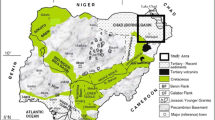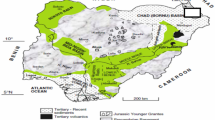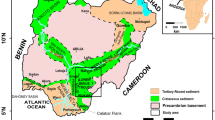Abstract
The northwest of Iran is considered as a promising geothermal zone owing to its geographical properties, tectonic features, and thermal activities, particularly in Sabalan geothermal field. Several large stratovolcanoes such as Sahand and Sabalan mountains in northwestern Iran, each of which has a vast central dome probably located on a tectonic plate, comprising of intrusive and effusive volcanic rocks. This study mainly aimed at performing the spectral analysis of aeromagnetic data to estimate Curie point depth (CPD), geothermal gradient and heat flow in the northwest of Iran using random magnetization (centroid method and forward modeling of the spectral peak method) and fractal magnetization (de-fractal method). The reduced-to-pole aeromagnetic data were divided into 55 overlapping blocks of 80 × 80 km. The derived range of CPD in the study area using the centroid method, forward modeling spectral peak method and de-fractal method were 9.2–13.9 km, 8.9–13.7 km and 7.2–12.9 km, respectively The derived values of heat flows in the study area using the above-mentioned methods were higher than 104 mW/m2, 105 mW/m2 and 120 mW/m2, respectively. The results of this study were found to have good correlations with wells data and resistivity measurements collected in the Northwest Sabalan geothermal field. Good consistency was also found between the CDPs and earthquake distribution. Moreover, the locations of hot springs and the maximum temperatures of the wells were associated with the variations in the modelled depth of the geothermal resources. Promising regions were in the northeast and southwest parts of the study area.

Modified from the structural map of the National Geoscience Database of Iran, NGDIR; http://www.ngdir.ir

Modified after Azad et al. (2011)





















Similar content being viewed by others
References
Aboud, E., Salem, A., & Mekkawi, M. (2011). Curie depth map for Sinai Peninsula, Egypt deduced from the analysis of magnetic data. Tectonophysics,506(1), 46–54.
Afshar, A., Norouzi, G. H., Moradzadeh, A., Riahi, M. A., & Porkhial, S. (2017). Curie point depth, geothermal gradient and heat-flow estimation and geothermal anomaly exploration from integrated analysis of aeromagnetic and gravity data on the Sabalan area, NW Iran. Pure and Applied Geophysics,174(3), 1133–1152.
Akbar, S., & Fathianpour, N. (2016). Improving the Curie depth estimation through optimizing the spectral block dimensions of the aeromagnetic data in the Sabalan geothermal field. Journal of Applied Geophysics,135, 281–287.
Amirpour-Asl, A., Ghods, A., Rezaeian, M., & Bahroudi, A. (2010). Depth of curie temperature isotherm from aeromagnetic spectra in Iran: Tectonics implications. In Tectonic crossroads: Evolving orogens of Eurasia-Africa-Arabia, Ankara, Turkey, Geological Society of America International Section, Abstracts with Program (Vol. 65).
Aydın, I., & Oksum, E. (2010). Exponential approach to estimate the Curie-temperature depth. Journal of Geophysics and Engineering,7(2), 113.
Azad, S. S., Dominguez, S., Philip, H., Hessami, K., Forutan, M. R., Zadeh, M. S., et al. (2011). The Zandjan fault system: Morphological and tectonic evidence of a new active fault network in the NW of Iran. Tectonophysics,506(1–4), 73–85.
Bansal, A. R., & Dimri, V. P. (1999). Gravity evidence for mid crustal domal structure below Delhi fold belt and Bhilwara super group of western India. Geophysical Research Letters,26(18), 2793–2795.
Bansal, A. R., & Dimri, V. P. (2001). Depth estimation from the scaling power spectral density of nonstationary gravity profile. Pure and Applied Geophysics,158(4), 799–812.
Bansal, A. R., Dimri, V. P., Kumar, R., & Anand, S. P. (2016). Curie depth estimation from aeromagnetic for fractal distribution of sources. In V. P. Dimri (Ed.), Fractal solutions for understanding complex systems in earth sciences (pp. 19–31). Cham: Springer.
Bansal, A. R., Dimri, V. P., & Sagar, G. V. (2006). Quantitative interpretation of gravity and magnetic data over southern granulite terrain using scaling spectral approach. Journal-Geological Society of India,67(4), 469.
Bansal, A. R., Gabriel, G., & Dimri, V. P. (2010). Power law distribution of susceptibility and density and its relation to seismic properties: An example from the German Continental Deep Drilling Program (KTB). Journal of Applied Geophysics,72(2), 123–128.
Bansal, A. R., Gabriel, G., Dimri, V. P., & Krawczyk, C. M. (2011). Estimation of depth to the bottom of magnetic sources by a modified centroid method for fractal distribution of sources: An application to aeromagnetic data in Germany. Geophysics,76(3), L11–L22.
Bédard, Karine, Comeau, Félix-Antoine, Raymond, Jasmin, Malo, Michel, & Nasr, Maher. (2018). Geothermal characterization of the St. Lawrence Lowlands sedimentary basin, Québec, Canada. Natural Resources Research,27(4), 479–502. https://doi.org/10.1007/s11053-017-9363-2.
Bhattacharyya, B. K., & Leu, L. K. (1977). Spectral analysis of gravity and magnetic anomalies due to rectangular prismatic bodies. Geophysics,42(1), 41–50.
Bilim, F., Akay, T., Aydemir, A., & Kosaroglu, S. (2016). Curie point depth, heat-flow and radiogenic heat production deduced from the spectral analysis of the aeromagnetic data for geothermal investigation on the Menderes Massif and the Aegean Region, western Turkey. Geothermics,60, 44–57.
Blakely, R. J. (1988). Curie temperature isotherm analysis and tectonic implications of aeromagnetic data from Nevada. Journal of Geophysical Research: Solid Earth,93(B10), 11817–11832.
Blakely, R. J. (1996). Potential theory in gravity and magnetic applications. Cambridge: Cambridge University Press.
Bogie, I., Cartwright, A. J., Khosrawi, K., Talebi, B., & Sahabi, F. (2000). The Meshkin Shahr geothermal prospect, Iran. In Proceedings of the world geothermal congress 2000, Kyushu-Tohoku, Japan (pp. 997–1002).
Bouligand, C., Glen, J. M., & Blakely, R. J. (2009). Mapping Curie temperature depth in the western United States with a fractal model for crustal magnetization. Journal of Geophysical Research: Solid Earth, 114(B11), 1–25.
Bromley, C., Khosrawi, K., & Talebi, B. (2000). Geophysical exploration of Sabalan geothermal prospects in Iran. In Proceedings of the world geothermal congress, Japan.
Connard, G., Couch, R., & Gemperle, M. (1983). Analysis of aeromagnetic measurements from the Cascade Range in central Oregon. Geophysics,48(3), 376–390.
Dimri, V. P., Bansal, A. R., Srivastava, R. P., & Vedanti, N. (2003). Scaling behaviour of real earth source distribution: Indian Case Studies. In T. M. Mahadevan, B. R. Arora, & K. R. Gupta (Eds.), Indian continental lithosphere: Emerging research trends, memoir geological society of India (Vol. 53, pp. 431–448).
Fedi, M., Quarta, T., & De Santis, A. (1997). Inherent power-law behavior of magnetic field power spectra from a spector and grant ensemble. Geophysics,62(4), 1143–1150.
Finn, C. A., & Ravat, D. (2004). Magnetic depth estimates and their potential for constraining crustal composition and heat flow in Antarctica. In AGU fall meeting abstracts.
Fotouhi, M. (1995). Geothermal development in Sabalan, Iran. In Proceedings of the world geothermal congress 1995, Florence, Italy (Vol. 1, pp. 191–196).
Ghaedrahmati, R., Moradzadeh, A., Fathianpour, N., Lee, S. K., & Porkhial, S. (2013). 3-D inversion of MT data from the Sabalan geothermal field, Ardabil, Iran. Journal of Applied Geophysics,93, 12–24.
Hsieh, H. H., Chen, C. H., Lin, P. Y., & Yen, H. Y. (2014). Curie point depth from spectral analysis of magnetic data in Taiwan. Journal of Asian Earth Sciences,90, 26–33.
Khojamli, A., Ardejani, F. D., Moradzadeh, A., Kalate, A. N., Kahoo, A. R., & Porkhial, S. (2016). Estimation of Curie point depths and heat flow from Ardebil province, Iran, using aeromagnetic data. Arabian Journal of Geosciences,9(5), 383.
Khojamli, A., Doulati Ardejani, F., Moradzadeh, A., Nejati Kalateh, A., Roshandel Kahoo, A., & Porkhial, S. (2017). Determining fractal parameter and depth of magnetic sources for Ardabil geothermal area using aeromagnetic data by de-fractal approach. Journal of Mining and Environment,8(1), 93–101.
Khosrawi, K. (2008). The geothermal resource in Sabalan, Iran. In Geothermal training programme, 30th anniversary workshop, United Nations University, August.
Kiyak, A., Karavul, C., Gülen, L., Pekşen, E., & Kiliç, A. R. (2015). Assessment of geothermal energy potential by geophysical methods: Nevşehir Region, Central Anatolia. Journal of Volcanology and Geothermal Research,295, 55–64.
KML. (1998). Sabalan geothermal project, stage 1-surface exploration, final exploration report. Report number 2505-RPT-GE-003.
Maden, N. (2010). Curie-point depth from spectral analysis of magnetic data in Erciyes stratovolcano (Central Turkey). Pure and Applied Geophysics,167(3), 349–358.
Maus, S., & Dimri, V. P. (1994). Scaling properties of potential fields due to scaling sources. Geophysical Research Letters,21(10), 891–894.
Maus, S., & Dimri, V. (1995). Potential field power spectrum inversion for scaling geology. Journal of Geophysical Research: Solid Earth,100(B7), 12605–12616.
Maus, S., Gordon, D., & Fairhead, D. (1997). Curie-temperature depth estimation using a self-similar magnetization model. Geophysical Journal International,129(1), 163–168.
McKenzie, D. (1972). Active tectonics of the Mediterranean region. Geophysical Journal International,30(2), 109–185.
Noorollahi, Younes, Bina, Saeid Mohammadzadeh, & Yousefi, Hossein. (2016). Simulation of power production from dry geothermal well using down-hole heat exchanger in Sabalan field, Northwest Iran. Natural Resources Research,25(2), 227–239. https://doi.org/10.1007/s11053-015-9270-3.
Noorollahi, Y., & Itoi, R. (2011). Production capacity estimation by reservoir numerical simulation of northwest (NW) Sabalan geothermal field, Iran. Energy,36(7), 4552–4569.
Noorollahi, Y., Itoi, R., Fujii, H., & Tanaka, T. (2008). GIS integration model for geothermal exploration and well siting. Geothermics,37(2), 107–131.
Noorollahi, Y., Yousefi, H., Itoi, R., & Ehara, S. (2009). Geothermal energy resources and development in Iran. Renewable and Sustainable Energy Reviews,13(5), 1127–1132.
Nwankwo, L. I., & Shehu, A. T. (2015). Evaluation of Curie-point depths, geothermal gradients and near-surface heat flow from high-resolution aeromagnetic (HRAM) data of the entire Sokoto Basin, Nigeria. Journal of Volcanology and Geothermal Research,305, 45–55.
Obande, G. E., Lawal, K. M., & Ahmed, L. A. (2014). Spectral analysis of aeromagnetic data for geothermal investigation of Wikki Warm Spring, north-east Nigeria. Geothermics,50, 85–90.
Okubo, Y., Graf, R. J., Hansen, R. O., Ogawa, K., & Tsu, H. (1985). Curie point depths of the island of Kyushu and surrounding areas, Japan. Geophysics,50(3), 481–494.
Pilkington, M., & Todoeschuck, J. P. (1993). The fractal magnetization of continental crust. Geophysical Reseach Letters,20, 627–630.
Porkhial, S., Abdollahzadeh Bina, F., Radmehr, B., & Johari Sefid, P. (2015). Interpretation of the injection and heat up tests at Sabalan geothermal field, Iran. In Proceedings world geothermal congress (pp. 19–25).
Porkhial, S., Ghomshei, M. M., & Yousefi, P. (2001). Geothermal energy in Iran. Weather,2002, 431–448.
Porwal, A., Carranza, E. J. M., & Hale, M. (2003). Knowledge-driven and data-driven fuzzy models for predictive mineral potential mapping. Natural Resources Research,12(1), 1–25.
Porwal, A., Carranza, E. J. M., & Hale, M. (2006). A hybrid fuzzy weights-of-evidence model for mineral potential mapping. Natural Resources Research,15(1), 1–14. https://doi.org/10.1007/s11053-006-9012-7.
Rao, C. R., Kishore, R. K., Kumar, V. P., & Babu, B. B. (2011). Delineation of intra crustal horizon in Eastern Dharwar Craton—An aeromagnetic evidence. Journal of Asian Earth Sciences,40(2), 534–541.
Ravat, D., Pignatelli, A., Nicolosi, I., & Chiappini, M. (2007). A study of spectral methods of estimating the depth to the bottom of magnetic sources from near-surface magnetic anomaly data. Geophysical Journal International,169(2), 421–434.
Rebai, A., & Goffinet, B. (1993). Power of tests for QTL detection using replicated progenies derived from a diallel cross. Theoretical and Applied Genetics,86(8), 1014–1022.
Ross, H. E., Blakely, R. J., & Zoback, M. D. (2006). Testing the use of aeromagnetic data for the determination of Curie depth in California. Geophysics,71(5), L51–L59.
Saibi, H., Aboud, E., & Gottsmann, J. (2015). Curie point depth from spectral analysis of aeromagnetic data for geothermal reconnaissance in Afghanistan. Journal of African Earth Sciences,111, 92–99.
Salem, A., Green, C., Ravat, D., Singh, K. H., East, P., Fairhead, J. D., et al. (2014). Depth to Curie temperature across the central Red Sea from magnetic data using the de-fractal method. Tectonophysics,624, 75–86.
Salem, A., Ushijima, K., Elsirafi, A., & Mizunaga, H. (2000). Spectral analysis of aeromagnetic data for geothermal reconnaissance of Quseir area, northern Red Sea, Egypt. In Proceedings of the world geothermal congress (Vol. 16691674).
Shuey, R. T., Schellinger, D. K., Tripp, A. C., & Alley, L. B. (1977). Curie depth determination from aeromagnetic spectra. Geophysical Journal International,50(1), 75–101.
Spector, A., & Grant, F. S. (1970). Statistical models for interpreting aeromagnetic data. Geophysics,35(2), 293–302.
Stampolidis, A., Kane, I., Tsokas, G. N., & Tsourlos, P. (2005). Curie point depths of Albania inferred from ground total field magnetic data. Surveys in Geophysics,26(4), 461–480.
Starostenko, V. I., Dolmaz, M. N., Kutas, R. I., Rusakov, O. M., Oksum, E., Hisarli, Z. M., et al. (2014). Thermal structure of the crust in the Black Sea: Comparative analysis of magnetic and heat flow data. Marine Geophysical Research,35(4), 345–359. (Suppl., Abstract T11A-1236).
Tanaka, A., Okubo, Y., & Matsubayashi, O. (1999). Curie point depth based on spectrum analysis of the magnetic anomaly data in East and Southeast Asia. Tectonophysics,306(3), 461–470.
Teknik, V., & Ghods, A. (2017). Depth of magnetic basement in Iran based on fractal spectral analysis of aeromagnetic data. Geophysical Journal International,209(3), 1878–1891.
Trifonova, P., Zhelev, Z., Petrova, T., & Bojadgieva, K. (2009). Curie point depths of Bulgarian territory inferred from geomagnetic observations and its correlation with regional thermal structure and seismicity. Tectonophysics,473(3–4), 362–374.
Waples, Douglas W. (2002). A new model for heat flow in extensional basins: Estimating radiogenic heat production. Natural Resources Research,11(2), 125–133. https://doi.org/10.1023/A:1015568119996.
Yousefi, H., Ehara, S., & Noorollahi, Y. (2007). Geothermal potential site selection using GIS in Iran. In Proceedings of the 32nd workshop on geothermal reservoir engineering, Stanford University, Stanford, California (pp. 174–182).
Yousefi, H., Noorollahi, Y., Ehara, S., Itoi, R., Yousefi, A., Fujimitsu, Y., et al. (2010). Developing the geothermal resources map of Iran. Geothermics,39(2), 140–151.
Author information
Authors and Affiliations
Corresponding author
Rights and permissions
About this article
Cite this article
Shirani, S., Nejati Kalateh, A. & Noorollahi, Y. Curie Point Depth Estimations for Northwest Iran Through Spectral Analysis of Aeromagnetic Data for Geothermal Resources Exploration. Nat Resour Res 29, 2307–2332 (2020). https://doi.org/10.1007/s11053-019-09579-1
Received:
Accepted:
Published:
Issue Date:
DOI: https://doi.org/10.1007/s11053-019-09579-1




